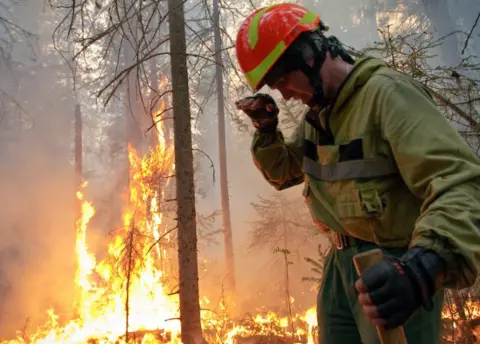Siberia wildfires: Russians battle to contain the blazes
The village of Podymakhino is blessed with a stunning location.
The great Siberian river, the Lena, flows past here. And, stretching into the distance, is lush green forest - the taiga. It's a picture postcard kind of place.
Suddenly the tranquil scene is interrupted by the sound of a helicopter. When it flies into view, I can see a giant bucket suspended on a cable. It's a hint of the drama unfolding over the hills - the battle against fire.
Forest fires in Siberia are common. But this summer unusually hot weather, dry thunderstorms and strong winds have combined to spark an emergency - in Siberia wildfires have engulfed an area the size of Belgium.
Reaching the blazes can be difficult. Most of the fires are in remote areas. In recent days, army planes and helicopters from the Russian emergency service have been dropping water on the flames. But often it's up to local communities to do what they can to contain the threat.
In Podymakhino I meet Gennady Esin. He runs a small farm and timber business, but by necessity he's a firefighter, too, now. Gennady and his team agree to take me into the taiga to show me the situation there. We set off on a military-style off-road truck, bumping along a dirt track. Soon we're deep in the forest, surrounded by silver birch, cedar and pine trees.
 EPA
EPAI spot smoke rising from the earth. The forest is smouldering. Small flames are licking at bushes and shrubs. The fire is greatest to one side of the track.
"We've used a bulldozer is create a fireline, a gap, in order to stop the fire spreading," Gennady explains. "In this gap, we've removed vegetation, like dry moss, leaves and twigs, anything combustible. We have to keep monitoring the situation to make sure that sparks don't cross the fireline."
This natural barrier has slowed the spread of the fire. But it hasn't stopped it completely. I can see burning, too, on the other side of the fireline.
Gennady's team has limited resources. A forester called Sergei walks round with a simple pump, extinguishing flames whenever he spots them. But catching all danger points in time is almost impossible. Fire can appear unexpectedly. In the forest one smouldering bush I was looking at suddenly burst into flames.
Another fire-fighting helicopter flies over.
"Wouldn't it be more effective," I ask Gennady, "to spray the forest from the air with tons of water?"
He shakes his head and points to a dead tree trunk lying on its side. Smoke is rising from one end.
"If the embers are burning inside dead wood like this," he tells me, "then dropping water from a plane or helicopter won't affect that."
I can see that one part of the forest has been badly affected by fire - reduced to a charred wasteland strewn with burnt trunks and branches.
 EPA
EPADue to the forest fires, a state of emergency is in place across Irkutsk region and in other parts of Siberia. Clouds of smoke have been spreading to towns and cities. In Ust-Kut, where I've been staying - one hour's drive from Podymakhino - a rare rainy day has provided temporary relief from the smog. But the smell of burning is returning.
"There was so much smoke here. At one point we couldn't see the sun through it," Ust-Kut pensioner Nadezhda Mikhailovna tells me. "I'm still sneezing because of all that smoke. We've only had one rainy day in weeks."
How much longer will the forests burn?
"That depends on Nature," Gennady tells me. "If it stays dry, then the fires will continue. In Siberia forests can burn until rain in October, or the first snow."
